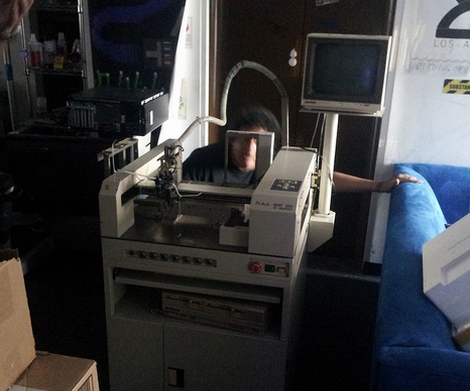
Professional-grade pick and place machines are quite pricey, so when the crew at Null Space Labs picked up an old Juki Placemat 360 for only $1,200, they were stoked. When they finally got it in-house however, they realized that the seller’s definition of “working” was a bit different than theirs. The machine’s compressor is busted, and there are all sorts of other bits that require some TLC before they can get things up and running again. They have put together a “build log” showing off their work as the machine is taken from an ancient, mostly-working relic to a lean, mean, picking and placing machine.
So far, they have torn the thing down and inspected the upgrades and damage the machine has been subjected to over the years. The crew started making a few small repairs, and have even replaced the unit’s laser with machine vision, which seems to be working well thus far during testing.
While you might not have any similar machinery in your workshop, it’s still fun to watch as they tear it down and revamp it, bit by bit.















Looks like a lot of hard work in this fix. Great effort
Please don’t teach robots to see. I don’t want this thing charging down the street with free will any sooner than necessary.
Actual, honest-to-goodness, 5.25″ FDDs! Are they the 360KB or the 1.2MB variety?
I don’t know for sure. This was CP/M so it was probably not 1.2MB or even 360 kb. The Kaybro CPM machine I think had about 370k while some commodore drives would do almost a meg. Back then even if the computers used the same OS they could have vastly different disk formats. The only “standard” for CP/M was the SS/SD 8″ format.
Wait I found it.
320k
http://www.mess.org/sysinfo:pc88srl
Looks just like a old Zevatech pick and place I used to work with.
They’re 40 track double sided 360KB disks.
We’ll be updating the log as we go. Next major part is the PCB rebuiilding
Having run one of these for a living I know what these guys have gone through. They did good on this one and show the true hacker spirit.
Wow, I can’t believe that thing runs on a PC-88. For a moment, I wondered if you could play Touhou 4 (Lotus Land Story) on that, but then I realized that it’s got a Z80 processor and not a 486.
You guys are doing a really nice job fixing it up. Good to see.
Hey, this is great guys! I have the exact same pick and place unit and went through the same pains getting it up and running about a year ago.
Thought I’d share a couple tips that I learned, you might already know them, or they might help. :)
I was having trouble with the autochanger detecting if a bit was attached. At first I thought it was the reed switch. But it turned out that it was actually the PS4 pressure switch. You can put it into test mode, drop a bit onto the rubber pad by the autochanger and then look for a red LED to light up on the PS4. Adjust the screw on the PS4 to get it just right.
The other tip is that I don’t even bother with the teaching light anymore. Screaming Circuits has an EAGLE ulp file that generates a centroid file with exact coordinates of your parts. It saves a LOT of time to just print out the centroid file and type the exact coordinates in instead of teaching each component location.
http://i.screamingcircuits.com/docs/ScreamingCircuits%20centroid%20ULP.zip
Hope this helps, and hope you guys have as much fun with your Juki as I have. :)
Jack.
Hi jack,
Yeah our reed switch was definitely out, the cable had a break in it. but thanks for the tip !
For the teaching I had initially planned to reverse the save format, convert the centroids to that and copy it back to the machine via the SD card. But instead we’re just throwing all the control side away and making our own.
What are you using for the controller? A beagle board would work and would be easy to network. Another and cheaper option might be a micro ITX board running linux. You could use the parallel port for digital io. You could use DOS but then networking would be a pain. I assume that you would want to network this.
@lwatcdr Stellaris LM39xxx ARM chip, custom board. It has usb and ethernet.
woah, I used to work for Zevatech and JUKI. Never thought I’d see one of their machines mentioned in a hack here. thanks for the trip down nostagia lane.
hello.. just wondering, how do you compute for the correct nozzle type for a specific product? is there a standard computation for the nozzle inner hole?
hope someone could answer..